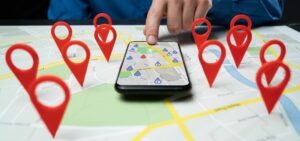Multichannel Marketing is on the way out! Omnichannel allows you to combine all your channels.
As we all know, there are thousands of ways we can market to our customers. In a shop, we can have deals and promotions. We can also use social media to promote what we sell, and traditional advertising is still in use.
However, when you use multi-channel marketing, none of your channels will be connected. Someone could talk to a customer service representative through Facebook, and go into your store, where the clerk won’t have a clue what they want.
The problem with this system is that it inconveniences the customer who has to explain the same question or issue with two or more different people. Today, customer expectations are higher than they were in the past, so the customer experience needs to be seamless.
What is Omnichannel Marketing? Plus examples!
The modern alternative to multi-channel marketing is what’s called omnichannel marketing. This is a system where all the channels are connected.
This method allows you to keep track of all of your customers, enabling you to understand what kind of person they are, and what they might be interested in buying.
For example, a customer might talk to someone through Facebook to ask them about particular products. When that customer creates an account on the online shop, their data will be passed from Facebook to the online account.
When the customer uses the online store for the first time, the store will already know a few things about them and be able to make recommendations that will benefit the customer.
Let’s say you run a furniture shop, and someone messages you on Facebook to ask if any of your products are made from sustainable wood. Already, you know that this person cares about the planet.
When they visit your online shop, you can recommend your most eco-friendly products to them.
Why does Omnichannel Marketing matter?
Most people don’t like it when you treat them as a means to an end; they want to feel like you value them as an individual.
Building an interpersonal relationship with your customers will make them view you as someone who cares about them.
Did you know that (according to one study by Deloitte) when companies show that they care about their customers, they can expect their profits to rise by around 60%? And having one loyal customer can be better than having five one-time customers- loyal customers are worth an average of 10x their original purchase (according to to CustomerThatStick).
Case Study: GameStop
One company who has used omnichannel marketing to their advantage is GameStop. You probably know them as the store you would go into when you were a kid to buy video games.
MobileMarketing has conducted a study on them.
Today, they have attributed 14% of their revenue from personalization.
What GameStop has done is integrate their store data to create a personalized website. Whenever a customer made a purchase in-store, they would use their purchase to make recommendations on their website.
For example, if you were to buy a war game, GameStop would know that you like action-packed, battle games, allowing them to recommend these kinds of games when you go onto their website. By doing this, they found their conversion went up by 29% and their average order value up by 35%.
What you should know about your customers when using Omnichannel marketing.
When tracking your customers, it’s important to learn a few things about them. Here are five questions that knowing about your customer will help you to give them a better customer experience.
Who am I?
You don’t need to write a biography about any of your customers, but knowing a few basics about what they like and what kind of person they are can go a long way.
What’s my intent?
Why does this person use you? Are they buying from you for personal or professional reasons? Do they buy for themselves or someone else?
Knowing what your customers intend to use your products can help you to find the best products for them.
What have I done in the past?
Generally, old habits die hard. If you know that someone has undergone a particular project in the past, there is a high chance they will do something similar in the future.
For example, if you own a bookstore, and someone has brought books about philosophy for their degree, you’ll know that philosophy is a subject they have an interest in.
What am I looking at?
Generally, when people look at something, it’s because we’re interested in buying it. If someone is looking at a particular item, you might want to recommend similar things.
Where am I?
Knowing where someone is will enable you to guide them to their nearest physical store, give them delivery information, or even let them know what’s popular where they are.
Seven Tips for when using Omnichannel Marketing
Isabel Hasty from SharpSpring has written a fantastic piece about what you should do if you choose to use Omnichannel Marketing.
The seven tips she provides will enable you to make the most out of this system and build a better relationship with your customers.
- A spreadsheet with every aspect of every customer would be one massive spreadsheet. So to help you organize your customers better, you should create “buyer personas”, and each customer should fit into at least one of the personas.
For example, you might have one persona who is a middle-aged man who uses you for their work. You might also have a young person who just uses you for fun.
- Segment your audience into whatever categories you see fit. You might want to separate them by where they live, how old they are, or what kind of person they are.
- By aligning your content with their journeys, people won’t be treated the same way every time they get in touch with you. Someone who has used you many times before will not be interested in a “beginners guide”.
- Although the idea of omnichannel marketing is that all your channels are aligned, you will still find that a lot of your communication is done through one channel. Make sure to give that one priority.
- Customer support are the people your customers go to when they have an issue. By investing in customer support, unhappy customers will be far likelier to change their tune.
- Make sure you keep on top of all the data. There’s no point in investing time in omnichannel marketing if you don’t know whether or not it’s making any difference.
- Make sure to integrate your findings. Be sure that the people who work in one sector have all the required information they need about each customer. Otherwise, your omnichannel marketing won’t be very effective.
Omnichannel Marketing in Real Estate
One industry that has not been optimising Omnichannel Marketing as much as they could do is the real estate industry.
When people make a purchase of several thousand or even million dollars, they’ll want to make sure they’re spending their money wisely. And by building an interpersonal relationship with their customers, realtors will stand a higher chance of making a sale.
People will think someone cares about where they will be living for the foreseeable future, and not just be after their wallet.
Before people buy a house, they will be looking at homes before they pick which one is best for them. Many will use social media or websites such as Zoopla to look at houses.
Should someone express an interest in a particular style of housing, realtors can use this information to recommend to them the types of houses they might be looking for. Other factors to consider will be where people live (or plan on living), whether or not they have, or plan on having children,
Omnichannel Marketing isn’t just online.
One common misconception is that it’s purely an online thing. In reality, it allows you to integrate your online and offline marketing platforms.
One great way of doing this is through “click and collect”. With this system, customers can order their products online and pick them up in-store.
When you have information about a customer, you’ll be able to give them relevant information when they go into your store.
For example, if you notice someone is buying a lot of meat and vegetables, you can point them towards special offers and deals when they pick up their stuff.
Brick and Mortar isn’t dead!
There’s a common misconception that the high street is dead. But the US Department of Statistics Says otherwise.
In 2016, $390 billion was made in online retail, but $2985 billion was made in brick and mortar stores.
In 2017, $453 was online and $3043 in-store.
This means that as late as 2017, 87% of retail shopping was done by people going into physical stores. Although I would imagine the balance might have been slightly different during the lockdowns.
Some of the reasons why you might prefer offline to online are…
- You can physically interact with the products
- You can ask shop assistants for help
- There is less hassle
- Returning items is easier
- You can try things on- better for clothing.
If you own a physical store, using omnichannel marketing can help your website, socials, and store work together to understand your customer and give them a better experience.
Conclusion
These days, customer expectations are very high. And you want to be sure that all of your customers leave from you feeling satisfied and wanting to come back.
By using omnichannel marketing, you can keep on top of everyone, and there won’t be a disconnect between interactions you have through your website, through your socials, and in your store.
Traditionally, there would be only one way of marketing. This was a method that we now call “multi-channel marketing”.
As we all know, there are thousands of ways we can market to our customers. In a shop, we can have deals and promotions. We can also use social media to promote what we sell, and traditional advertising is still in use.
However, when you use multi-channel marketing, none of your channels will be connected. Someone could talk to a customer service representative through Facebook, and go into your store, where the clerk won’t have a clue what they want.
The problem with this system is that it inconveniences the customer who has to explain the same question or issue with two or more different people. Today, customer expectations are higher than they were in the past, so the customer experience needs to be seamless.
Thumbnail Designed by Freepik















